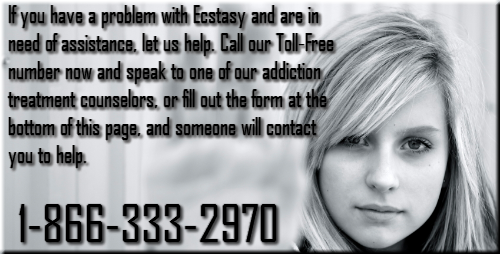Ecstasy Effects
- Ecstasy Addiction
- Ecstasy Overdose
- Ecstasy and Brain Damage
- Dangers of Ecstasy
- Ecstasy Side Effects
- Ecstasy Long Term Effects
- Ecstasy Deaths
- Ecstasy Addiction Treatment
- Symptoms of Ecstasy Use
Ecstasy Information

Symptoms of Ecstasy Use
One of the most difficult aspects of ecstasy abuse for parents and providers to address is that often the symptoms of ecstasy use are unclear. Many of the physical effects and symptoms of ecstasy use can be misconstrued as just feeling down or under the weather. One of the very hazardous symptoms of ecstasy use is promiscuity. Ecstasy users often do things they would not have done if they were sober at the time. This might include participating in risky unprotected sex or taking other unwise chances.
Ecstasy is most often available in tablet form and is usually ingested orally. It is also available as a powder and is sometimes snorted and occasionally smoked, but rarely injected. The symptoms of ecstasy use last approximately four to six hours. Users of the drug say that it produces profoundly positive feelings, empathy for others, elimination of anxiety, and extreme relaxation. Ecstasy is also said to suppress the need to eat, drink, or sleep, enabling users to endure two- to three-day parties. Consequently, ecstasy use sometimes results in severe dehydration or exhaustion.
Users of the drug often build a tolerance to its effects and soon begin taking more than one pill just to get the same effect as before. As this behavior continues they become dependent on the drug psychologically. Ecstasy users commonly report a "burnout" for one-two days after using. This burnout is characterized by tiredness, soreness, and dullness of the senses or mental processes. These symptoms of ecstasy use are a direct result of the temporary depletion of certain neurotransmitters in the brain.
Taking ecstasy has been linked with a wide range of symptoms of ecstasy use. These symptoms of ecstasy use include impaired memory, chronic depression, anxiety, panic attacks, sleeplessness, "de-personalization", "de-realization", reduced cognitive ability, flashbacks, hallucinations, and paranoid delusions.
Looking past the physical and psychological symptoms of ecstasy use, one can determine if their loved one is abusing the drug by noticing the presence of paraphernalia linked with ecstasy use. Items that seem harmless to most but may be associated with ecstasy use include: pacifiers, lollipops, candy necklaces, glow sticks or glowing jewelry, mentholated rub, and surgical type masks. Pacifiers and lollipops are frequently used to prevent the symptoms of ecstasy use such as grinding one’s teeth and involuntary jaw clenching. Candy necklaces are used to hide ecstasy pills. Glow sticks, mentholated rub, and surgical masks are used to enhance the user’s senses while on ecstasy.
Symptoms of ecstasy use include:
-
an intense focus on sights and sounds

- blurred vision
- chills or sweating
- confusion
- dehydration
- depression
- dizziness
- headaches
- inability to sleep
- irritability the day after consuming ecstasy (this is due to the depletion of serotonin in the user’s brain)
- loss of inhibitions
- muscle tension
- panic attacks
- rapid eye movement
- severe anxiety and/or paranoia
- sore jaw (involuntary jaw clenching is a side effect of ecstasy use)
- trance-like state
- unusual displays of affection
- use of Tiger Balm for cramps
- vomiting or nausea
